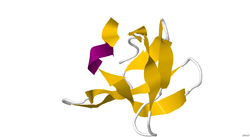Nebulin
| NEB | |||||||||||||||||
|---|---|---|---|---|---|---|---|---|---|---|---|---|---|---|---|---|---|
 |
|||||||||||||||||
| |||||||||||||||||
| Identifiers | |||||||||||||||||
| Aliases | NEB, nebulin, NEB177D, NEM2 | ||||||||||||||||
| External IDs | MGI: 97292 HomoloGene: 136285 GeneCards: NEB | ||||||||||||||||
| |||||||||||||||||
| Orthologs | |||||||||||||||||
| Species | Human | Mouse | |||||||||||||||
| Entrez | |||||||||||||||||
| Ensembl | |||||||||||||||||
| UniProt |
| ||||||||||||||||
| RefSeq (mRNA) | |||||||||||||||||
| RefSeq (protein) |
| ||||||||||||||||
| Location (UCSC) | Chr 2: 151.49 – 151.73 Mb | Chr 2: 52.14 – 52.34 Mb | |||||||||||||||
| PubMed search | [1] | [2] | |||||||||||||||
| Wikidata | |||||||||||||||||
| View/Edit Human | View/Edit Mouse |
Nebulin is an actin-binding protein which is localized to the thin filament of the sarcomeres in skeletal muscle. It is a very large protein (600–900 kDa) and binds as many as 200 actin monomers. Because its length is proportional to thin filament length, it is believed that nebulin acts as a thin filament "ruler" and regulates thin filament length during sarcomere assembly.[3] Other functions of nebulin, such as a role in cell signaling, remain uncertain.
Nebulin has also been shown to regulate actin-myosin interactions by inhibiting ATPase activity in a calcium-calmodulin sensitive manner.[4]
Mutations in nebulin cause some cases of the autosomal recessive disorder nemaline myopathy.[5]
A smaller member of the nebulin protein family, termed nebulette, is expressed in cardiac muscle.
Structure
The structure of the SH3 domain of nebulin was determined by NMR.[6] The SH3 domain from nebulin is composed of 60 amino acid residues, of which 30 percent is in the beta sheet secondary structure (7 strands; 18 residues).
Knockout phenotype
As of 2007, two knockout mouse models for nebulin have been developed to better understand its in vivo function. Bang and colleagues[7] demonstrated that nebulin-knockout mice die postnatally, have reduced thin filament length, and impaired contractile function. Postnatal sarcomere disorganization and degeneration occurred rapidly in these mice, indicating the nebulin is essential for maintaining the structural integrity of myofibrils. Witt and colleagues[8] had similar results in their mice, which also died postnatally with reduced thin filament length and contractile function. These nebulin-knockout mice are being investigated as animal models of nemaline myopathy.
References
- ↑ "Human PubMed Reference:".
- ↑ "Mouse PubMed Reference:".
- ↑ McElhinny AS, Kazmierski ST, Labeit S, Gregorio CC (Jul 2003). "Nebulin: the nebulous, multifunctional giant of striated muscle". Trends in Cardiovascular Medicine. 13 (5): 195–201. doi:10.1016/S1050-1738(03)00076-8. PMID 12837582.
- ↑ Root DD, Wang K (Oct 1994). "Calmodulin-sensitive interaction of human nebulin fragments with actin and myosin". Biochemistry. 33 (42): 12581–91. doi:10.1021/bi00208a008. PMID 7918483.
- ↑ Pelin K, Hilpelä P, Donner K, Sewry C, Akkari PA, Wilton SD, Wattanasirichaigoon D, Bang ML, Centner T, Hanefeld F, Odent S, Fardeau M, Urtizberea JA, Muntoni F, Dubowitz V, Beggs AH, Laing NG, Labeit S, de la Chapelle A, Wallgren-Pettersson C (Mar 1999). "Mutations in the nebulin gene associated with autosomal recessive nemaline myopathy". Proceedings of the National Academy of Sciences of the United States of America. 96 (5): 2305–10. doi:10.1073/pnas.96.5.2305. PMC 26779
 . PMID 10051637.
. PMID 10051637. - ↑ PDB: 1NEB; Politou AS, Millevoi S, Gautel M, Kolmerer B, Pastore A (February 1998). "SH3 in muscles: solution structure of the SH3 domain from nebulin". J. Mol. Biol. 276 (1): 189–202. doi:10.1006/jmbi.1997.1521. PMID 9514727.
- ↑ Bang ML, Li X, Littlefield R, Bremner S, Thor A, Knowlton KU, Lieber RL, Chen J (Jun 2006). "Nebulin-deficient mice exhibit shorter thin filament lengths and reduced contractile function in skeletal muscle". The Journal of Cell Biology. 173 (6): 905–16. doi:10.1083/jcb.200603119. PMC 2063916
 . PMID 16769824.
. PMID 16769824. - ↑ Witt CC, Burkart C, Labeit D, McNabb M, Wu Y, Granzier H, Labeit S (Aug 2006). "Nebulin regulates thin filament length, contractility, and Z-disk structure in vivo". The EMBO Journal. 25 (16): 3843–55. doi:10.1038/sj.emboj.7601242. PMC 1553189
 . PMID 16902413.
. PMID 16902413.
Further reading
- Björklund AK, Light S, Sagit R, Elofsson A (Sep 2010). "Nebulin: a study of protein repeat evolution". Journal of Molecular Biology. 402 (1): 38–51. doi:10.1016/j.jmb.2010.07.011. PMID 20643138.
External links
- nebulin at the US National Library of Medicine Medical Subject Headings (MeSH)
- GeneReviews/NCBI/NIH/UW entry on Nemaline Myopathy